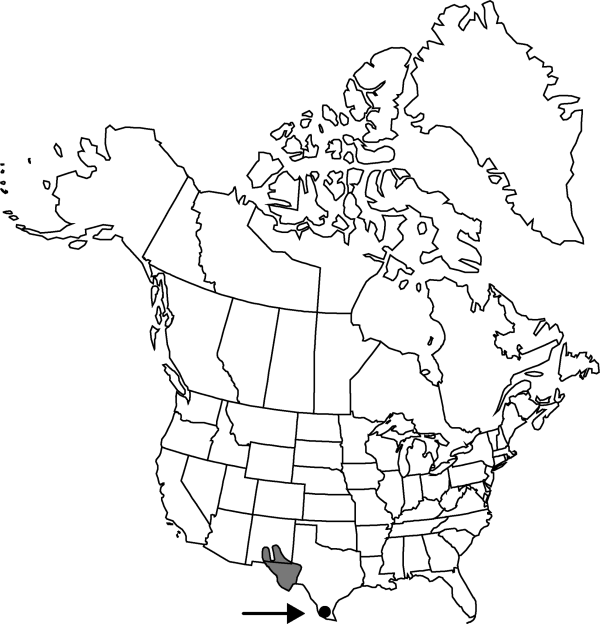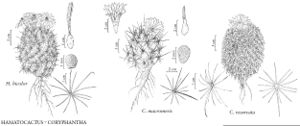Coryphantha macromeris
Cactées, 35. 1868.
Plants profusely branched, ultimately forming low mats or hemispheric mounds to 100 cm diam., immature branches sometimes predominant, conspicuously tuberculate with projecting spines. Roots ± succulent in largest, often massive and difficult to excavate. Stems deep-seated, aerial portion conspicuous, hemispheric to short cylindric, shape sometimes obscured by profusion of immature branches, 5–23 × (1.5–)4–8(–13.5) cm; tubercles unusually large, conspicuous, (10–)15–38(–45) × 6–15 mm, ± flaccid or flabby; areolar glands seasonally conspicuous; areolar grooves short, extending 1/2–3/4 distance from spines toward tubercle axils; parenchyma mucilaginous; pith narrow, ca. 1/10 of lesser stem diam.; medullary vascular system absent. Spines 7–21[–55] per areole; radial spines (3–)9–15(–18) per areole, white, gray, tan, or brown, (9–)16–25(–50) mm; subcentral spines 2–3 in adaxial part of areole; central spines (1–)3–8 per areole, (tan to) pale gray to black, abaxial central spine porrect or descending, others weakly appressed or ± projecting spines, slightly curved, usually angular in cross section (terete), sometimes flat and grooved on 1 side and rounded on the other, often slightly flexible, (15–)25–35(–55) mm, all equal or abaxial spine longest. Flowers apical or nearly so, 30–50(–60) × (30–)40–70 mm; outer tepals heavily fringed; inner tepals 20–25 per flower, bright rose-pink or magenta, often with darker midstripes and paler margins, 30–40 × 4.5–6 mm; outer filaments greenish white throughout or distally purplish pink; anthers bright yellow; stigma lobes 6–13, white or pale yellow, 3–6 mm. Fruits dark green, ovoid to obpyriform or ellipsoid, (10–)13–25(–30) × 12–18 mm; floral remnant strongly persistent. Seeds reddish brown, ± comma-shaped to spheric, 1.2–1.5 mm, finely and weakly raised-reticulate. 2n = 22.
Phenology: Flowering Feb–Sep; fruiting (May-)Aug–Dec.
Habitat: Chihuahuan desert scrub, Tamaulipan thorn scrub, nearly all substrates including nearly pure gypsum, gravelly soils, usually sandy alluvium or clay, rarely crevices or steep slopes
Elevation: 30-1700(-2000) m
Distribution

N.Mex., Tex., Mexico (Chihuahua, Coahuila, Durango, Zacatecas).
Discussion
Southern Texas populations of Coryphantha macromeris contain atypical individuals with proliferating small stems and shorter (stunted?) spines. Sexually mature stems branch from the tubercle axils, and the whole shoot becomes covered by immature branchlets. The immature branchlets proliferate profusely and asymmetrically faster than they can reach sexual maturity, obscuring the underlying symmetry of mature stems and forming irregular, asymmetric mounds. Such plants are the basis for C. macromeris var. runyonii (Britton & Rose) L. D. Benson, but they do not grow in pure populations. Therefore the name runyonii can not be used at varietal rank without including plants morphologically similar to typical C. macromeris from the Chihuahuan Desert.
Stunted or immature Coryphantha macromeris are variable, keying to Coryphantha with some difficulty, often having only 5–7 radial spines and lacking central spines. The strongly mucilaginous cortex is a useful field mark; even small slices of living tubercle tissue are visibly and tangibly slimy.
Selected References
None.
